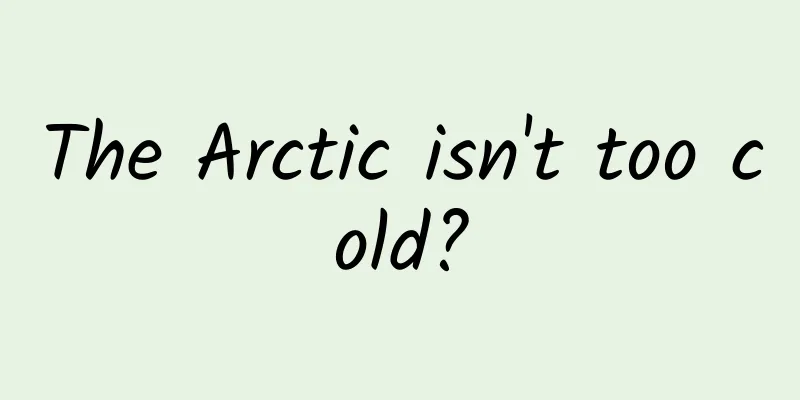The Arctic isn't too cold?

|
Arctic Earth's North The total area exceeds 21 million square kilometers Arctic Zone (Arctic region range diagram, the countries shown are those with part of their territory in the Arctic region, map by @张伟&王申雯/Planet Research Institute) ▼ 1.84 million square kilometers of glaciers Covering land (Part of the Greenland ice sheet, image source: @Visual China) ▼ 11 million square kilometers of sea ice Frozen Ocean (Large expanses of floating Arctic sea ice, image source: @Visual China) ▼ High in the sky Extremely cold Arctic vortex Ready to go south Use cold waves to invade all directions (Due to the temperature difference between the Arctic and other regions, there are long-term Arctic vortices and polar front jets over the Arctic and surrounding areas, which bind the cold air in the polar regions; the figure below is a schematic diagram of the Arctic vortex and polar front jet, drawn by @王申雯/Planetary Research Institute) ▼ but Frozen polar regions But this is not the normal state of the earth Icehouse Earth at the poles In the 4.6 billion years of Earth Very few occurrences But for humans This frozen Arctic is very important In a world that is getting hotter The fate of the remote Arctic It will affect each of us (A polar bear jumps on the ice, photographer @沈辉) ▼ Who froze the North Pole? What kind of power is it? Let it melt quickly? Everything started thousands of years ago. The coming of "winter" 01 Winter is coming Unlike Antarctica, which is mainly land The Arctic is centered on the Arctic Ocean Surrounded by land There are only a few channels such as the Bering Strait and the Norwegian Sea It can connect the Arctic Ocean to the outside world (Schematic diagram of the Arctic Ocean. Different organizations have different definitions of the Arctic Ocean. This article uses the marginal seas shown in the figure as the boundary of the Arctic Ocean. Map by @Zhang Wei/Planetary Research Institute) ▼ This also makes the Arctic Ocean The world's smallest ocean Only more than 14 million square kilometers 7.7% of the Pacific Nickname: "Arctic Mediterranean" A vast continental shelf extends into the seabed of the Arctic Ocean Except for the three mid-ocean ridges The four basins separated by the sea are deeper. The average depth of the Arctic Ocean is only about 1,200 meters. The shallowest ocean in the world (Please watch in horizontal mode, the topography of the Arctic Ocean seabed is shown here. Map by @张伟&王申雯/Planetary Research Institute) ▼ Such a sea-land pattern After tens of millions of years of geological evolution Early in this evolution The earth is still very warm The surface temperature of the Arctic Ocean can even reach 23°C Comparable to today's subtropical But geological movements thousands of kilometers away It is about to plunge the earth into bitter cold About 80 million years ago Extensive and sustained mountain building From the European Alps Zagros via Iran To the Himalayas of Asia Create a huge super orogenic belt And continues to this day (Sketch of global plate movement since the late Cretaceous, drawn by @王申雯&郑艺/Planetary Research Institute) ▼ The mountains gradually rise A large amount of fresh rock exposed on the surface Gradually destroyed by rain, snow, wind and frost Complex chemical reactions with the atmosphere Consumes a lot of carbon dioxide Reduces greenhouse effect So much so that in the last 55 million years The Earth is beginning to cool down About 13 million years ago The surface waters of the Arctic Ocean are gradually freezing Formation of extensive year-round sea ice (Please watch in horizontal mode, Arctic sea ice, image source: @Visual China) ▼ As the Earth continues to cool The Arctic Ocean will soon be completely frozen Land around the Arctic It also began to be covered with ice and snow About 7 million years ago Snow in Greenland Gradually compacted into ice Glacier formation (Glaciers in Greenland, image source: @Visual China) ▼ As global temperatures gradually decrease Glaciers expand from high to low From land to sea Become a white cliff standing on the sea Thick and magnificent (Please watch in horizontal mode, the glaciers extending to the sea in the Svalbard Islands, photographer @梅元皎) ▼ When extended to the sea Glaciers are affected by gravity, waves, etc. Break, collapse, disintegration Formed icebergs floating on the sea (Icebergs in the waters near Greenland, photographer @Thomas Look at the World) ▼ The volume of glaciers on land is growing The scope is getting bigger About 2.75 million years ago The vast glaciers surrounding the Arctic Ocean They have connected to each other to form a huge, thick ice body It can cover all the valleys and ridges below. The Ice Sheet is Born (Please watch in horizontal mode, overlooking the ice sheet of Greenland, image source: Visual China) ▼ So far The entire Arctic and surrounding areas Became the white dome of the earth Plus, from about 34 million years ago The Antarctic is gradually covered by ice sheets. The Earth is officially frozen at the poles "Icehouse Earth" (When both the North and South Poles of the Earth are covered with a large amount of ice, it is called "Icehouse Earth". The "Icehouse Earth" period we are in now is only the third time in the history of nearly 500 million years; please watch it in horizontal mode. The picture shows the glaciers on the Svalbard Islands. Photographer @陈建伟) ▼ However Under the overall cold tone of the earth There is also a small alternation of cold and warm Every hundreds or even tens of thousands of years The Earth's orbital posture changes slightly The amount of solar energy received fluctuates The climate also changes between glacial periods and interglacial periods. During the coldest ice age The Arctic ice sheet is extremely large It can extend southward to 37°N Greenland, most of North America, northern Eurasia Almost completely covered Plus the contribution of the Antarctic ice sheet and the alpine glaciers on land Global sea levels could drop by more than 100 meters (As the Earth's climate changes periodically, the range and volume of the ice sheet have also been changing. The Last Glacial Maximum, about 20,000 years ago, was the coldest moment closest to us, when the sea level dropped by about 130 meters. The figure below shows the range of the ice sheet during the Last Glacial Maximum, with the coastline showing the position after the sea level dropped by 130 meters. Map by @王申雯&张伟/Planetary Research Institute) ▼ But the interglacial period after the glacial period The global climate will warm up again About 12,000 years ago The most recent ice age ended Rapid warming The vast ice sheet retreated again The modern Arctic as known to humans Beginning to take shape 02 Ice and Snow Trail Ice retreats toward the mountains and north On the land outside the Arctic Leaving behind many glacial landforms In the Arctic and surrounding mountains Glaciers retreat from the foothills to the top of the mountain or disappear Leaving many sharp edges Sharp horns There is also a U-shaped glacial trough (Glacier landforms in Gates of the Arctic National Park in Alaska, image source: Visual China) ▼ Whether it is the Scandinavian Mountains in Northern Europe Brooks Range, Alaska The Arctic and surrounding mountains Because of the extremely rich glacial landforms Showing a fierce attitude (Glacier landforms on the Norwegian island of Senega, which is part of the Scandinavian Mountains, photographer @Cycad) ▼ in Fjords shaped by glaciers in the coastal mountains Particularly special (Please watch in horizontal mode, the fjord landscape of Greenland, photographer @Thomas looks at the world) ▼ In the cold ice age Glaciers have carved out many U-shaped valleys among the mountains. As glaciers retreat, sea levels rise Seawater gradually floods the U-shaped trough And continue to extend inland The deep and narrow fjord was born (Schematic diagram of fjord formation, drawn by @王申雯/Planetary Research Institute) ▼ Located in Greenland Scoresbysund Fjord Length reaches 350 km And has many branches like branches It forms one of the largest fjord systems in the world. (Satellite image of Scoresbysund Fjord in Greenland, image source @NASA) ▼ The Scandinavian Mountains Norway across the country There are nearly 1,200 fjords. The coastline has become extremely winding Total length exceeds 25,000 km About 90% of them are located on both sides of the fjord. (Distribution of fjords along the Norwegian coast, map by @Chen Zhihao/Planet Research Institute) ▼ Beyond the mountains Glaciers retreating northward The secrets of the world beneath the ice were revealed In more distant times As these glaciers developed and expanded southward In the weak spots of the surface rock Many depressions were carved out Now, as the glaciers retreat, they are gradually exposed. After being filled with meltwater Forming a network of glacial lakes (Schematic diagram of the formation of glacial lakes, drawn by @王申雯/Planetary Research Institute) ▼ Finland has a quarter of its territory within the Arctic Circle There are nearly 190,000 lakes Like countless gems inlaid on the earth (The heart-shaped glacial lake in Finland is a small lake affiliated with Lake Pagani. Image source: Visual China) ▼ The largest lake, Saimaa The area reaches 4,400 square kilometers Embracing thousands of islands (Please watch horizontally, Lake Saimaa, the largest lake in Finland, picture source: Visual China) ▼ Ancient glaciers Shaped the face of parts of the Arctic But the Arctic is still cold Widespread permafrost It also created some more bizarre landscapes When groundwater freezes and expands The upper soil was lifted up Many hills were formed on the earth Frost heave (Frost heaves in Tuktoyaktuk, Northwest Territories, Canada, photographer @Kristian Binder) ▼ For surface water bodies in permafrost areas Due to repeated freezing and thawing The ground gradually collapsed and water accumulated Forming countless melt lakes (Schematic diagram of the formation of a thermal melt lake, drawn by @王申雯/Planetary Research Institute) ▼ When looking down from a high altitude These melt lakes are densely distributed and have various shapes. In the vast northern land Depicting unexpected patterns (Dense thermal melt lakes in the Yamal Peninsula of Siberia, image source @Visual China) ▼ After a long period of ablation and retreat In today's Arctic Glaciers have largely retreated from the continents outside the Arctic Only remains on the islands outside the Arctic Ocean For example, among the mountains of Svalbard More than 1,600 glaciers meandering This archipelago covers an area of only more than 60,000 square kilometers. More than half of the land Covered by glaciers (Glaciers on the Svalbard Islands, image source: @Visual China) ▼ Greenland The Arctic's remaining ice sheet is preserved Total area exceeds 1.7 million square kilometers Covers 85% of Greenland's landmass (Greenland ice sheet scene, image source: Visual China) ▼ Glaciers from the Arctic land A big retreat The extent of sea ice It is no longer as good as the Ice Age (Arctic Sea Ice, image source: Visual China) ▼ It changes with the seasons. March after winter The Arctic Ocean has the largest sea ice area It can extend to the Pacific and Atlantic Oceans The total area reaches 15.4 million square kilometers And in September after midsummer Only 6.4 million square kilometers remain Retreat to the Arctic Ocean (The above data are the average values of the Arctic Ocean sea ice extension range in March and September from 1981 to 2010; the figure below is a schematic diagram of the Arctic Ocean sea ice extension range in winter and summer, drawn by @张伟/Planetary Research Institute) ▼ Small warming against the backdrop of an icehouse Earth Retreating Arctic ice It not only reshaped the face of the Arctic It also makes various plants and animals Return to the Arctic Turning the Arctic into A hot land for living beings (Sea ice and polar bears in the Arctic Ocean, image source: Visual China) ▼ 03 A land of living beings Land near the Arctic Circle The Arctic is a relatively warm place Although the annual average temperature is often less than 5℃ But the forests composed of coniferous trees such as pine, spruce, and fir Still growing here in patches This is the boreal forest. Taiga (Please watch in horizontal mode, the northern taiga in Siberia, image source: @Visual China) ▼ Its scope Extends from 50 degrees north latitude to 70 degrees north latitude Covers most of Eurasia and northern North America With about 11.5% of the Earth's land area The largest biota in the world It is also the northernmost forest in the world. (Sketch of boreal coniferous forests, drawn by @张伟&王申雯/Planetary Research Institute) ▼ Whenever winter comes These conifers will stop growing. Entering hibernation There is also a slight separation of the cell wall and the intracellular material Even if ice forms between cells It is also difficult for ice crystals to form inside cells To avoid damage When summer comes They are "awakened" at lower temperatures. To take advantage of the short summer growing season (Landscape of the northern taiga in the Western Sayan Mountains in southern Siberia, image source: @Visual China) ▼ With such ability They grow densely in the Arctic Spreading thousands of miles Become a world of ice and snow King of the Forest (Please watch in horizontal mode, the northern coniferous forest in the Ural Mountains in winter, image source: @Visual China) ▼ In places with higher latitudes and colder temperatures Nor can northern coniferous forests grow Another plant community Begin to show their abilities This is made up of mosses, lichens, herbs And some small shrubs, etc. Tundra (Tundra vegetation near the Greenland Ice Sheet, image source: @Visual China) ▼ These seemingly fragile plants In the northernmost land of the earth Showing vitality Its distribution area exceeds 11 million square kilometers (Sketch of the range of tundra in the Northern Hemisphere, drawn by @张伟&王申雯/Planetary Research Institute) ▼ Winters here often drop to -30℃ Tundra plants tend to have a slow pace of life Two years or even longer Complete it slowly The entire life cycle of germination, growth and flowering To prevent freezing Some tundra plants also have Store fat, sugar and other substances To lower the freezing point Gain the ability to resist cold (Tundra vegetation under Ula Peak in Greenland, photographer @Thomas Look at the World) ▼ Beyond Plants Arctic Animals They have also evolved ways to cope with the cold. Cold seawater can dissolve more oxygen Plus the continuous sunshine for several months in summer Large amounts of phytoplankton are blooming in the Arctic Ocean Various fish, krill, etc. feed on it Attracts a variety of predators (Killer whales in the Arctic Ocean, image source: Visual China) ▼ 17 species of whales including killer whales, narwhals, bowhead whales, etc. Every year I come to the Arctic They have extremely thick skin and fat layers. Some species have a fat layer up to half a meter thick. Become an excellent cold-resistant "equipment" (Two humpback whales, also known as humpback whales, in the waters near Greenland, picture source @Visual China) ▼ Pinniped mammals such as walruses and seals They have a similar strategy to whales to keep warm There is also a lot of fat accumulated under the skin Make them look cute (A bearded seal lying on the Arctic sea ice, photographer @徐征泽) ▼ But don't be fooled by their slow movement on land Thick fat also brings a streamlined appearance Very good for underwater activities Make them the most flexible fat people in the polar regions (Walrus underwater, image source: Visual China) ▼ On the Arctic land Herbivorous animals such as reindeer and musk ox Have strong hooves In winter when the ground is covered with snow Uncovering tundra plants hidden deep beneath the snow (Two musk oxen on the snowfield of Wrangel Island, Russia, photo source: @Visual China) ▼ Carnivorous animals such as Arctic foxes The color of the hair changes in different seasons Snow-white in winter In summer, it changes to brown like rock soil Blending in with the environment Help them hide in the dark and wait for opportunities to hunt (An Arctic fox on the Svalbard Islands, photographer @徐征泽) ▼ And has a huge body of 2-3 meters And the whole body of milky white hair Polar Bear The undisputed star of the Arctic (Polar bear standing on ice, image source: @Visual China) ▼ The world's largest extant terrestrial carnivore It has a huge weight of 350-700 kg Can run on ice at a speed of 40 kilometers per hour and swim in water at a speed of 10 kilometers per hour Athletes in the Arctic The powerful forefoot Huge, sharp canine teeth And the patience to wait for a long time This makes polar bears the northernmost species on Earth. Top terrestrial predator Even large animals such as seals, walruses, and even whales It’s also in their recipes (Polar bear mother and cub looking for prey, photo source: @Visual China) ▼ Rich in Biodiversity Energizing the Arctic More than 10,000 years ago Modern humans continue to migrate Finally set foot in this far north land They live and hunt here. Adapting to the extreme environment of the Arctic (Reindeer are of great significance to human society in the Arctic, photographer @LuDi__) ▼ People adapt to local conditions They make a living by hunting seals, whales and other animals The prey is rich in fat Providing them with food security to resist the severe cold Eating raw meat also makes them lack fruits and vegetables. Able to get enough vitamin C No risk of sepsis (Inuit hunting, picture source: Visual China) ▼ The wisdom of mankind They also gradually learned Using ice and snow as houses and animal skins as clothing Raising sled dogs and reindeer As friends across species Also used as a means of transportation (Sami village and reindeer, photographer @吴邺霖) ▼ With a unique lifestyle Humans spread across the Arctic In Greenland, Northern Europe, Siberia, etc. Formed the Inuit, Sami, Yakut, etc. Unique Arctic Aboriginal Culture And it continues to this day (Tent camp of nomadic reindeer, picture source: @Visual China) ▼ But outside the Arctic The world we live in is changing rapidly Especially in modern times Huge amounts of greenhouse gases are emitted by industrial activities Triggered rapid and dramatic global warming The Arctic's extreme cold is being reversed A disruptive change Has quietly begun 04 The Arctic isn't too cold. Due to the impact of human activities Global average temperature from 1900 to present The temperature increased sharply by about 1℃ Looking at the history of the last thousand years Straight up Due to the polar amplification effect Arctic warming About twice the global average temperature rise Reaching an astonishing 2°C Almost as hot as the Earth (Anomaly diagram of warming in the Arctic. By comparing the temperature anomaly distribution and average warming curve between the Arctic and the world, it can be seen that the warming in the Arctic is significantly higher than the global average. Map by @郑艺/Planet Research Institute) ▼ The Arctic is melting Greenland's ice sheet continues to melt Cold fresh water is rapidly flowing into the North Atlantic Thermohaline circulation affects the global distribution of heat between land and sea Becoming unstable Bringing more uncertainty to the global climate (The glacial river formed by meltwater on the Greenland Ice Sheet is a sign that the ice sheet is melting. Image source: @NASA) ▼ Arctic sea ice is melting rapidly The area is gradually shrinking In a future summer The Earth's white dome may no longer exist (Changes in the extent of Arctic Ocean summer sea ice, map by @Zhang Wei & Wang Shenwen/Planetary Research Institute) ▼ For humans A rapidly melting Arctic First of all, it contains huge opportunities As fossil fuels remain the world's main energy source Driven by huge profits The global oil industry Targeting the Arctic’s rich oil and gas Found in Siberia, Alaska, and northern Canada Even the oil and gas resources deep in the Arctic Ocean continental shelf It will become easier to develop (Natural gas processing plant in Siberia, image source: @Visual China) ▼ Relying on coal mines and metal mineral development The towns that were built Murmansk, Russia or Longyearbyen, Norway As the climate warms Ushering in greater development (Please watch in horizontal mode. Longyearbyen, Norway, is known as the northernmost town on Earth at 78°13′ north latitude. Photographer: @Su Tie) ▼ After the massive melting of sea ice The Arctic route through the Arctic Ocean may be opened Significantly save time on intercontinental voyages Create more wealth for people (Arctic route diagram, drawn by @陈志浩&王申雯/Planetary Research Institute) ▼ But on the other hand The rapidly melting Arctic It also contains a huge threat Increasing resource development activities Will threaten the fragile ecological environment in the Arctic The Arctic's unique biodiversity There will undoubtedly be a huge impact (A polar bear mother and her cub walk past a pile of scrap steel. Image source: Visual China) ▼ Melting permafrost The infrastructure in and around the Arctic Becoming "shaky" in the mud (Railway tracks deformed by melting permafrost in northern Russia, image source: @Visual China) ▼ also There are more than 1.6 trillion tons of carbon stored in the world's frozen soils More than twice the amount of carbon in the atmosphere Most of them are distributed around the Arctic Scientists call it "permafrost carbon bomb" If all this carbon enters the atmosphere as methane This could cause a significant rise in temperature Bring disastrous consequences to human society (The methane explosion that occurred in the Yamal Peninsula of Siberia in 2015 left a large pit on the surface, and similar methane explosion events are becoming more and more frequent. Image source: @Visual China) ▼ Warming in the Arctic It will also destabilize the Arctic vortex and polar jet stream. Make it easier for cold air to move south Warm air is more likely to move northward People living in the Northern Hemisphere In the context of global warming Experiencing more extreme cold snaps and heat waves (Illustration of the Arctic vortex and polar front jet stream under different conditions, drawn by @王申雯/Planetary Research Institute) ▼ It is almost certain that For a long time in the future The Arctic will continue to change But this is the Arctic A changing Ice and Hot Earth It has experienced a change from no ice to ice In the last 2 million years Together with Antarctica, The modern world with ice covering both poles Give humans a chance Witness the Earth's 4.6 billion years Extremely rare "Icehouse Earth" (Aerial photography of the icy rivers and lakes on the Greenland ice sheet, image source: @Visual China) ▼ It experiences the Earth's own rhythm of warmth and coldness In the last 100,000 years Together with Antarctica, we are changing the face of the Earth with ice and snow Shaping a world known to humans (Please watch in horizontal mode, an icebreaker sailing in the Arctic sea ice, image source: @Visual China) ▼ now Rapid global warming caused by human activities The Arctic Towards a warmer future Run all the way (Greenland Uummannaq town and sea icebergs, photographer @Thomas Look at the World) What does the future hold for the Arctic? Or hundreds of millions of years later The Earth will emerge from the "ice chamber" again No more ice and snow at the poles Or tens of thousands of years later Earth's orbit will change again The Ice Age is coming again Arctic returns to peak (Polar bear under the Arctic ice cliff, photographer @徐征泽) ▼ In the near future that humans can perceive The fate of the Arctic It is in the hands of each of us Although we are just small individuals But the choices of countless tiny individuals It can also become a huge torrent of the times (Trossum, Norway, illuminated by the Northern Lights, photographer @陈灿铭) ▼ The future of the Arctic You and I will continue to write And smart humans What choice will be made? This article was created by Written by Ding Haoyun Dances in the Empty City Editor | Director of Yunwukongcheng Photo | Zhou Xuguang Design | Wang Shenwen Map | Zhang Wei, Chen Zhihao, Zheng Yi Proofreading | Yunwukongcheng Map review | Chen Jingyi Cover Photographer | Xu Zhengze LuDi__ References [1] Wang Pinxian et al. Earth System and Evolution[M]. Science Press, 2018. [2] Qin Dahe. Introduction to Cryospheric Science (revised edition)[M]. Science Press, 2018. [3]Liu Nanwei. Physical Geography (3rd Edition)[M]. Science Press, 2014. [4] Ma Danwei. Plant Geography (Second Edition)[M]. Science Press, 2012. [5] Jiang Shizhong. Meteorology and Climatology[M]. Science Press, 2010. [6] Alan P. Trujillo, Harold V. Thurman. Introduction to Oceanography[M]. Publishing House of Electronics Industry, 2017. [7] David Birney. Encyclopedia of Animals[M]. Nanfang Daily Press, 2019. [8]Ruddiman, William F. Earth's Climate: past and future (Third Edition)[M]. Macmillan, 2014. [9] Li Xuejie, Wan Ling, Wan Rongsheng, et al. Geological structure and evolution of the Arctic Ocean[J]. Polar Research, 2010(3):271-285. [10]Newton, A. Arctic ice across the ages. Nature Geosci 3, 304 (2010). [11]Brouillette, Monique. "How microbes in permafrost could trigger a massive carbon bomb." Nature 591.7850 (2021): 360-362. [12]In't Zandt, Michiel H., Susanne Liebner, and Cornelia U. Welte. "Roles of thermokarst lakes in a warming world." Trends in Microbiology 28.9 (2020): 769-779. [13]Batchelor, Christine L., et al. "The configuration of Northern Hemisphere ice sheets through the Quaternary." Nature communications 10.1 (2019): 1-10. [14]Bird, Kenneth J., et al. Circum-Arctic resource appraisal: Estimates of undiscovered oil and gas north of the Arctic Circle. No. 2008-3049. US Geological Survey, 2008. Planetary Research Institute Focus on exploring the extreme world from a geographical perspective ···THE END··· |
<<: Why do "singing gods" always appear in bathrooms? | Science Museum
Recommend
One picture to understand the 2017 Apple conference/the most expensive iPhone in history is born
On September 13, Beijing time, the annual iPhone ...
Elements and channels of online product promotion plan!
Viewpoint 1: The general promotion process is as ...
How to do a good competitive product analysis? What are the common methods?
There are many articles on the Internet about wri...
Inventory: Do you still remember these 19 terrible mobile phones of this century?
Some of these phones you remember, and may have e...
Is your skin dry and itchy in winter? These few methods are simple and effective →
Whether adults or children, many people will enco...
Apple 'still investigating' three unpatched security flaws in iOS 15
In early September, security researcher Denis Tok...
Why do we need to analyze user behavior?
1. What is user behavior ? User behavior is compo...
It understands everything you say, AliOS upgrades scene intelligent semantic understanding
"I'm going to open the sunroof and liste...
Life lies in stillness? A breakthrough in the secret of human blood clots lies in the hibernation of bears!
Although humans often regard themselves as the &q...
Java vs. Node.js: An Epic Battle
[[160272]] Image source: Photo by Flickr user Tsu...
How much does it cost to customize a skin care product mini app in Hezhou?
According to industry insiders, mini programs wil...
GuessGame——Guessing Game
Source code introduction GuessGame——Guess, paper-...
There are more and more strange-looking dogs, some even look like aliens. Why is this happening?
There are many kinds of pet dogs nowadays, with s...
What is the specific situation of Mongolia donating 20,000 masks? Where are these masks shipped from?
On March 2, the Mongolian Red Cross donated 20,00...
Don’t worry if you forget to bring your ID card when taking the train home for the Spring Festival! Here is the latest travel guide on 12306 APP
As the Spring Festival approaches, many people ha...









